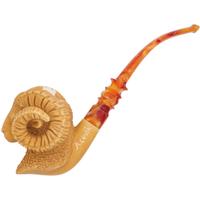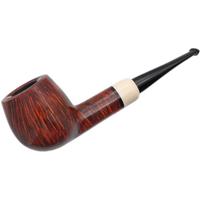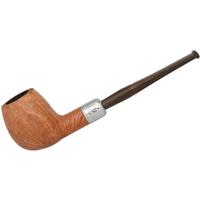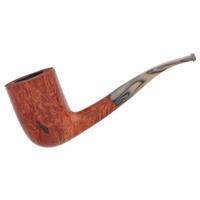The weird reddish and brown colors occasionally seen, which range all the way down to total black, have always been found (in my experience) on stems that had had their "dot hole" drilled too deeply and cut into the airway. Meaning years of wicked / migrating moisture, tars, and cleaning solvents are probably the cause.
Dunhill White Spot Drama
- Thread starter georged
- Start date
- Status
- Not open for further replies.
Being a guitarist who has been using cellulose picks for over 50 years I can tell you that introducing heat to that material is like lighting flash paper. Given the time period we are discussing I'm not surprised by the outcome. Cellulosic materials were used in many products so it makes sense that Dunhill employed them.
Fascinating.............. Great experiment!......
This gives me a lot to think about.........
-I wonder if they put a celluloid dot in their ivory stemmed pipes?
-I wonder if the ivory stemmed pipes were actual ivory, or celluloid?
- Now we know how to test for a well done replacement stem, you know, those done so well that its nearly impossible to tell.......... except for that ivory dot in the stem............... 8)
This gives me a lot to think about.........
-I wonder if they put a celluloid dot in their ivory stemmed pipes?
-I wonder if the ivory stemmed pipes were actual ivory, or celluloid?
- Now we know how to test for a well done replacement stem, you know, those done so well that its nearly impossible to tell.......... except for that ivory dot in the stem............... 8)
Brian actually did address the "Black Dot" Dunhills on a radio episode a long time back. He said those Black Dot pipes were a result of the tars discoloring the ivory white dot insert in the stem that Dunhill used at the time.
Clearly your pipe must have had a white dot that wasn't ivory, but I don't think one pipe out of the thousands that Dunhill produced is enough to definitively state that Dunhill never used ivory for their white dot.
Clearly your pipe must have had a white dot that wasn't ivory, but I don't think one pipe out of the thousands that Dunhill produced is enough to definitively state that Dunhill never used ivory for their white dot.
Yeah, it does.Clearly your pipe must have had a white dot that wasn't ivory, but I don't think one pipe out of the thousands that Dunhill produced is enough to definitively state that Dunhill never used ivory for their white dot.
Think it through, OK?
"That's glue. The celluloid rod is a couple thousandth's smaller in diameter than the hole."
Many thanks for the clarification George
Regards,
Jay.
Many thanks for the clarification George
Regards,
Jay.
Forgive me if I take Brian Levine's word over that of some guy on a forum who's profile picture is a random cat.Yeah, it does.
Think it through, OK?
John Loring claimed that black dots didn't exist, that they were the result of shoe polish, and admitted that he'd never seen one. He was wrong. Brian is wrong.Brian actually did address the "Black Dot" Dunhills on a radio episode a long time back. He said those Black Dot pipes were a result of the tars discoloring the ivory white dot insert in the stem that Dunhill used at the time.
I own an 1949 black dot, and there's nothing even remotely brown about it. Moreover, that dot was created with a slightly convex top, such that it becomes visible when light plays over it from certain angles. Now, whether that was an aftermarket addition, or a custom order that Dunhill fulfilled, I don't know. The freaking pipe is 60 years old, and I've had it for 30+ years, long before "black dots" were a thing or Loring wrote about them.
And when it comes to the mechanics of pipes and their materials, I'll believe a master restorer over a radio jock any day. But anyone can be wrong from time to time.
"...some guy on a forum who's profile picture is a random cat."
I doubt George's cat is any old random moggy.
Regards,
Jay.
I doubt George's cat is any old random moggy.
Regards,
Jay.
What an awesome experiment! Great documentation as well.
Sable, I too own a "black dot," from 1955. Mine looks consistent with discoloration, I believe. I'll have to take a better look at it. I love this kind of stuff.
Sable, I too own a "black dot," from 1955. Mine looks consistent with discoloration, I believe. I'll have to take a better look at it. I love this kind of stuff.
This comment surprised me given how long you have been here. I don't wish to blow smoke up his arse but surely you're aware he's not just some guy on a forum and that he's an experienced and respected restorer whose work and knowledge has proven exceptional. Not bad for a cat. In the few years that I have been frequenting this place, I have come to trust his knowledge when it comes to pipes and their materials and I suspect that most here have. That must make him something of an authority I would think but as previously mentioned, everyone can be wrong.Forgive me if I take Brian Levine's word over that of some guy on a forum who's profile picture is a random cat.
Well put, jazz.
I also doubt that Brian was making a considered call on the composition of the dot.
I also doubt that Brian was making a considered call on the composition of the dot.
"
Well, no it doesn't.
Fantastic experiment and post, though. Now we know that many of the ivory dots out there aren't ivory at all.
Yeah, it does."Clearly your pipe must have had a white dot that wasn't ivory, but I don't think one pipe out of the thousands that Dunhill produced is enough to definitively state that Dunhill never used ivory for their white dot.
Well, no it doesn't.
Fantastic experiment and post, though. Now we know that many of the ivory dots out there aren't ivory at all.
I'll say it again: think it throughWell, no it doesn't.
Fantastic experiment and post, though. Now we know that many of the ivory dots out there aren't ivory at all.
1) Celluloid was/is literally indistinguishable from ivory (as the perpetuation of the century-long myth demonstrated)
2) Cost effectively nothing
3) Was locally and readily available
4) Is MUCH easier and faster to work with (ivory is a bitch to grind and shatters when clipped, so must be either carefully cut off with a tiny saw, or clipped wastefully long and then tediously ground flush)
and
5) it even weighs less, which would save on delivery/shipping costs of bulk material
.
There is no imaginable reason to to think real ivory was ever used, and no examples ever found by anyone I've ever known in the hobby. Or even heard of.
Anyone who wants to "hold out" is welcome to, of course, but Strength of Belief has no more affect on reality in this case as it has in any other, whether elves, abominable snowmen, UFOs, or talking to the dead. With the experiment in this thread, the burden of proof has reversed itself. Until a real ivory dot is found, it is logically correct to assume they were celluloid all along.
george, you're being obtuse (and windy).
This, by the way, just restates the point you want to make: "There is no imaginable reason to to think real ivory was ever used, and no examples ever found by anyone I've ever known in the hobby. Or even heard of."
I think you're probably right about ivory never having been used, but testing one stem doesn't prove whether or not ivory stems were ever used. Just think it through.
This, by the way, just restates the point you want to make: "There is no imaginable reason to to think real ivory was ever used, and no examples ever found by anyone I've ever known in the hobby. Or even heard of."
I think you're probably right about ivory never having been used, but testing one stem doesn't prove whether or not ivory stems were ever used. Just think it through.
George,
While I agree with you and with the points that you're made, it isn't unreasonable to test this more than once to settle the point. If you've got some old orphaned stems that aren't candidates for restoration fodder, what bad can come from testing out a few others?
With any of the researching we do with vintage pipes and their history, most of what we rely upon are dips in the river. The more dips we take, the more we can rely on our findings.
While I agree with you and with the points that you're made, it isn't unreasonable to test this more than once to settle the point. If you've got some old orphaned stems that aren't candidates for restoration fodder, what bad can come from testing out a few others?
With any of the researching we do with vintage pipes and their history, most of what we rely upon are dips in the river. The more dips we take, the more we can rely on our findings.
What I'm wondering is whether ivory was used at some point early on and then (silently) switched to celluloid at some point much earlier than anyone previously thought. It might have happened, might not. Testing a stem from the 1930s, say, doesn't say anything dispositive about white dots from before that date.
To be clear, I applaud your new discovery -- totally changes what we thought about Dunhill dots. Brilliantly done.
To be clear, I applaud your new discovery -- totally changes what we thought about Dunhill dots. Brilliantly done.
Further developments (as the saying goes):
I just spoke with Rob again, who spoke with Howard Smith, the chief archivist of the Dunhill Museum.
Howard says unequivocally that celluloid was indeed the early "ivory" material, and that no claim was ever made by the company that real ivory was used. (How the myth started is unknown)
I just spoke with Rob again, who spoke with Howard Smith, the chief archivist of the Dunhill Museum.
Howard says unequivocally that celluloid was indeed the early "ivory" material, and that no claim was ever made by the company that real ivory was used. (How the myth started is unknown)
- Status
- Not open for further replies.












